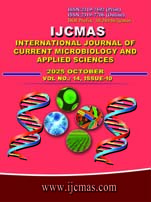


 National Academy of Agricultural Sciences (NAAS)
National Academy of Agricultural Sciences (NAAS)

|
PRINT ISSN : 2319-7692
Online ISSN : 2319-7706 Issues : 12 per year Publisher : Excellent Publishers Email : editorijcmas@gmail.com / submit@ijcmas.com Editor-in-chief: Dr.M.Prakash Index Copernicus ICV 2018: 95.39 NAAS RATING 2020: 5.38 |
Soil sodicity poses a significant challenge to rice (Oryza sativa L.) production, especially in the salt-affected regions of India. This study aimed to evaluate the combining ability of rice genotypes for yield and morphophysiological traits under sodic soil conditions using a Line × Tester mating design. Thirteen diverse lines and four testers were crossed to produce 52 F? hybrids, which were evaluated along with their parents under sodic conditions during the Kharif seasons of 2023 and 2024. Significant variation among genotypes was observed for all eleven traits studied, indicating ample genetic diversity. Line × Tester analysis revealed that specific combining ability (SCA) variance was higher than general combining ability (GCA) variance for most traits, suggesting the predominance of non-additive gene action. Among the parents, lines such as NDRK 5081, NDRK 5012, and NDRK 50030 were identified as good general combiners for grain yield and associated traits, while some genotypes like NDRK 5082 showed poor GCA effects. Testers such as IR 6 and CSR 28 also demonstrated favorable GCA for key traits under sodic conditions. Several hybrids, including NDRK 5081 × IR 6 and NDRK 5012 × CSR 28, exhibited high SCA effects for grain yield, plant height, and panicle length, making them promising candidates for hybrid development. The findings highlight the potential of utilizing both additive and non-additive gene actions through the selection of superior parental lines and hybrids for improving rice performance in sodic soils.
Ahmed, M.S., Begum, S., Kabir, M.E., and Islam, M.S. (2020). Combining ability analysis for yield and yield contributing traits in rice under saline conditions. The Agriculturists, 18(1): 1–11.
Bhowmick, P. K., Nayak, D. K., and Shukla, V. D. (2019). Combining ability analysis for yield and yield-related traits in hybrid rice (Oryza sativa L.). Oryza, 56(2): 164–172.
Choudhary, H.K., Chauhan, M.P., and Kumar, A. (2019). Genetic studies for combining ability in rice under sodic soil. Journal of Pharmacognosy and Phytochemistry, 8(2), 1883–1887.
Choudhary, M., Singh, S. K., Kumar, R., and Kumar, A. (2019). Studies on combining ability for yield and its components in rice (Oryza sativa L.). International Journal of Chemical Studies, 7(2): 965-969.
Griffing, B. (1956). Concept of general and specific combining ability in relation to diallel crossing systems. Australian Journal of Biological Sciences, 9(4): 463-493. https://doi.org/10.1071/BI9560463
ICAR-CSSRI (2020). Annual Report 2020-21. ICAR-Central Soil Salinity Research Institute, Karnal, India.
Islam, M.A., Haque, M.M., and Islam, M.R. (2020). Genetic variability and combining ability in rice (Oryza sativa L.) under salt stress condition. Bangladesh Journal of Plant Breeding and Genetics, 33(1): 25–34.
Kempthorne, O. (1957). An Introduction to Genetic Statistics. John Wiley and Sons, New York.
Minhas, P. S., and Sharma, D. R. (2006). Management of soil sodicity in the Indo-Gangetic alluvial plains of India. Arid Land Research and Management, 20(3): 205–221.
Patel, J.R., Patel, R.T., Patel, A.J., and Patel, D.U. (2014). Combining ability analysis in rice (Oryza sativa L.) using line × tester method. Electronic Journal of Plant Breeding, 5(1): 54–59.
Rabbani, M.G., Sarker, U., and Roy, B. (2013). Genetic variability, correlation and path analysis for yield and yield components in rice. Bangladesh Journal of Agricultural Research, 38(1): 1–9.
Rashid, M. A., Begum, S. N., Islam, M. M., and Akter, A. (2017). Combining ability and heterosis analysis for yield and yield contributing traits in hybrid rice (Oryza sativa L.). Rice Research, 5(3): 1000193.
Rashid, M. A., Begum, S., and Hasan, M. J. (2017). Combining ability and heterosis in hybrid rice for yield and yield contributing traits. Bangladesh Journal of Agricultural Research, 42(3): 475–488.
Rashid, M.H., Mian, M.A.K. and Begum, S. (2017). Combining ability and heterosis analysis in rice under salt-affected condition. Journal of Agriculture and Rural Development, 15(1): 67–74.
Sharma, R., and Kumar, R. (2019). Advances in rice breeding for improving yield and resilience. Rice Science, 26(6): 347-355.
Singh, R.K. and Chaudhary, B.D. (1985). Biometrical Methods in Quantitative Genetic Analysis. New Age International.
Tan, Y. F., and Li, Z. K. (2001). Molecular marker-assisted selection for agronomic traits in rice. Euphytica, 122(1): 119-126.
Yadav, S. K., Shukla, S., Singh, H. N., and Rai, V. (2021). Genetic analysis of grain yield and related traits in rice under sodic soil condition. Journal of Cereal Research, 13(1): 43-49.
Yadav, S.K., Kumar, S., and Kumar, S. (2021). Genetic variability and combining ability analysis in rice (Oryza sativa L.) for grain yield and its attributes under saline condition. International Journal of Chemical Studies, 9(4): 210–215.
Yaduvanshi, N. P. S., Sharma, D. R., and Swarup, A. (2014). Management of sodic soils and waters for sustainable agriculture. In: Abrol, I. P. et al., (Eds.), Salt-Affected Soils and Crop Production. ICAR, New Delhi. |
 |
 |
 |
 |